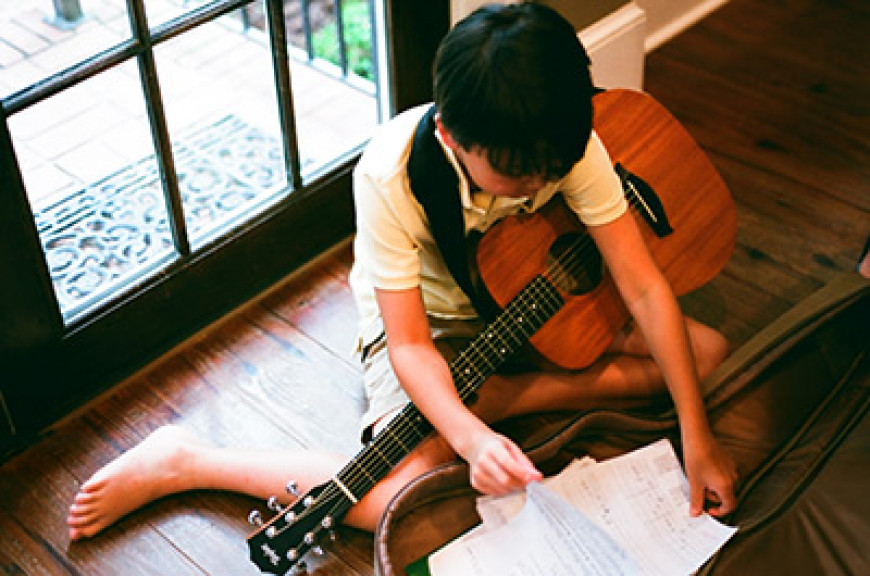Outside of the Music Lesson: Setting Goals, Practicing, & Performing

| Lessonface Parents Guide |
|---|
Other great reading:
|
Your role in your child’s musical growth, especially in practicing the instrument, likely will change as your child grows. The young child may need a lot of guidance and reinforcement to stick with a practice routine. Older, more independent children can manage their own practice schedules.
Setting Goals
Your child’s teacher should be able to help you and your child develop wise, achievable goals. And recognizing the progress that your child makes can be crucial for sustaining interest. Consider kicking off the first lesson by taking a short video of your child playing (if it can be called such). Then take another video each month or quarterly, as seems appropriate. Being able to see improvement can be immensely encouraging to a child.
Practice Schedules
It’s imperative to communicate with your child about the importance of regularly scheduled music lessons and practice routines. Having a set practice routine teaches your child responsibility and commitment and gives them stability. Regular practice can aid your child immensely in developing skill. Considering the spacing effect you and your child may wish to consider more digestible periods (perhaps 15-30 minutes) twice a day as opposed to a single session for twice that time, but of course your child’s teacher can help your child develop a specific practice regimen. Forming good practice habits will not only help your child improve at the instrument, but the general discipline and work ethic developed can positively carry over into other areas of life.
It can be helpful for you to supervise your child’s practice routine, at least at first. Of course you can’t sit with your child during practices forever, but your supervision can be helpful until he or she can practice alone. If you and your child are struggling with a practice schedule, you may want to consider other times of day outside the busy afternoons/evenings. NPR’s Anastasia Tsioulcas writes “In our house, the mood, and the amount of stuff we could accomplish in less than 10 minutes changed really dramatically when we switched from practicing in the early evenings to getting it done before school.”
Intentional or Deliberate Practice
For practice to be effective, it needs to be what’s called intentional/deliberate practice – not goofing off. While some goofing off with the instrument can be wonderful, and playing the instrument should be fun, goofing off is not the same as practicing. For a small child, you might want to focus on just a measure or two in a song a week, for 5-10 minutes a day outside of the lesson.
Practice Duration
Depending on the age, goals, and knowledge level of your child, how long to practice the instrument will vary for each child. For beginner students, practice sessions should be fairly short. In your child’s first year of playing an instrument, it is important that he/she enjoys the instrument and the time spent on practicing it. As your child’s knowledge of the instrument deepens and the complexity of the music increases, he/she should increase the practice duration to a point where your child is comfortable with and where he/she can accomplish the goals set for that week. For a very young beginner, practicing 5 minutes a day may be all the student can handle. As the child progresses, 30 minutes per day (one skip day a week!) might be the right number. Your teacher will be able to help you assess and set guidelines. And if you are working towards an audition or state band tryouts, practice sessions may become longer. As noted above, you may wish to consider spacing the overall practice time into two sessions, each for half as long, to see if improvement happens more quickly under those circumstances, as some have found to be the case.
Practice Environments
When your child is practicing, you should keep distracting noise and activities to a minimum to the extent possible. For example, you may want to keep any other children entertained in another room during your child’s practice, and turn off your computer and television if possible. In addition, consider setting up a dedicated area of your home where your child can practice without disruptions. To avoid wasting time searching for items, gather and store all the necessities, such as music stands, tuners, metronomes, and sheet music, in that dedicated area. Also, having a special space devoted to practicing may aid your child in concentrating on the music at hand.
Your Presence as a Parent
During the early stages of your child’s music learning experience, you should consider being present at lessons and during practice times, if your schedule will at all allow it. You can learn along with your child, take notes of important points during the lesson, and follow the teacher’s instructions when practicing at home. You do not actually have to play the instrument, but it can be helpful for you to understand sufficiently to help or correct your child when he/she encounters a problem.
More Ideas for Encouraging Practicing Intentionally – and Playing
Keeping up the practice routine is often one of the biggest challenges of learning to play an instrument – at any age. Parents and teachers have come up with many ingenious ways of keeping their children at it. You might want to make sure you leave the instrument where your child can access it at any time. If it’s in as close a reach as an iPad or Playstation, perhaps they will reach for it instead.
Playing Music Outside of the Lessons
Competitions/Festivals
There likely are various competitions, both domestically and internationally, for your child’s instrument. Although there might be additional pressure placed on your child about winning, some children thrive on the pressure and welcome the recognition of playing their best or the simple participation in a competition. There are also festivals where you child can meet other teachers and students, offering a chance to interact with fellow musicians as well as exposure to other teaching styles.
Exams
Although music exams are not suited for everyone, they are ways to validate the hard work that your child has put into learning and practicing the instrument. In preparing for the exams, not only will your child have to learn and play various styles or types of music pieces, he or she will have exposure to non-performing skills, such listening, music theory, and music history. You may want to talk to your child’s music teacher about whether these circumstances are right for your child.
Band/Orchestra
Joining a youth band/orchestra at or outside school is a great way for your child to display his or her musical talents. It also provides the chance to interact and play with other instruments and students.
Forming a Band
Your child can create a band and show off chops performing at coffeehouses, nursing homes, hospitals, or other venues. The praise, encouragement, and applause from these endeavors may further foster interest in the music.
Tell-Tale Signs for Change
Even with careful research and the best intentions in mind, it is impossible to guarantee musical results that you expect. In that case, it’s worthwhile considering making a change!
A change of teachers or teaching styles might be needed if your child still enjoys playing music but dreads going to lessons. A change of instruments might be warranted if your child shows interest in another instrument or finds playing a particular instrument too hard to handle. Maybe a change of your overall expectations and goals is what’s needed to reignite the passions and enthusiasm that your child had displayed early on in the learning process. Finally, maybe at the moment, your child is too young or doesn’t have the patience to sit through the lesson and practice routines. In that case, you might consider pausing and revisiting the instrument again when your child is older.
Of course, the relationships between a teacher and a student or a student and instrument(s) is a process of evolution, and it makes sense to thoroughly consider changes before jumping from one thing to another.




